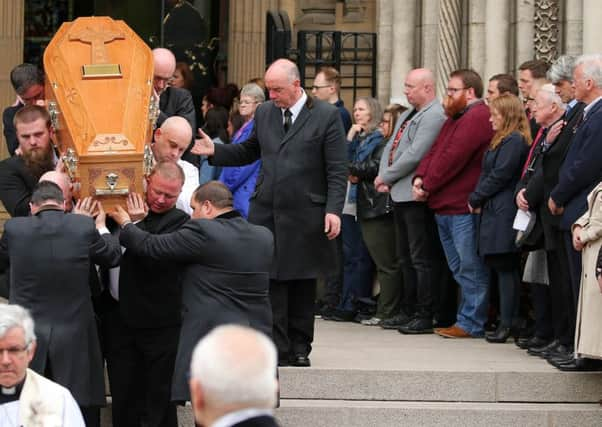Sam McBride: A remarkable result, yet Northern Ireland was here 50 years ago


Alliance, the Greens and People Before Profit were squeezed, seeing their share of the vote fall. With tribal politics to the fore, the expectation was that fear of the other side and the weakness of the UUP and SDLP would prompt voters to flock in increasing numbers to the DUP and Sinn Fein.
Instead, something remarkable has happened. The electorate has moved away from those two communal champions but has bypassed both the ‘soft’ unionist and nationalist parties and the ‘hard’ TUV to go to three alternatives which are agnostic on the tribal divide.
Advertisement
Hide AdAdvertisement
Hide AdIt is all the more remarkable because until very recently there was scant evidence of any widespread pressure from supporters of Stormont’s duopoly parties to compromise in order secure the return of devolution.


Why then did voters suddenly shift? The answer may lie in events beyond the control of party spin doctors and campaign managers.
In a low-key election campaign, the single most significant political act – seen by virtually everyone – came at the funeral of the murdered young journalist Lyra McKee.
The words of Fr Martin Magill, interpreted as a stinging rebuke to the DUP and Sinn Fein, captured the mood of a large section of the public, particularly those who are of the slain 29-year-old writer’s ceasefire generation.
Advertisement
Hide AdAdvertisement
Hide AdThe DUP and Sinn Fein had framed the election as a quasi-border poll. But in the wake of such a tragedy, running an overtly orange and green campaign would have been crass and that strategy was largely abandoned.
Whether it was public horror at the murder itself or the inability of the big two parties to deploy their familiar tribal messages which saw voters move towards the centre and the non-tribal left, the shift is unmistakable.
To state that this is a seismic break with all that has gone before would be to ignore history. Northern Ireland has on several occasions looked to be shifting towards parties not defined by the constitutional question, only for voters to revert to traditional orange and green voting patterns.
Just a few years into the Troubles, Alliance took 14.4% of the vote in the 1973 council elections. As late as 1987, Alliance polled 10% of the vote in that year’s general election.
Advertisement
Hide AdAdvertisement
Hide AdBut the party fell into a long descent which reached a nadir in the 1999 European election when the then Alliance leader Sean Neeson took just 2.1% of the vote
Even before the emergence of the Alliance Party, there had been significant evidence of a desire among a minority of the population for a different form of politics. In the 1964 general election, the non-sectarian Northern Ireland Labour Party took 16.1% of the vote.
What is new compared to past Alliance breakthroughs is that this time the party is not alone. Its vote (11.5%), together with that of the Greens (2.1%) and People Before Profit (1.4%), represents 15% of all votes cast in Northern Ireland.
History shows that there is no inevitability to that result representing the beginning of a trend. If the DUP and Sinn Fein return to Stormont, voters may decide to reward those parties, feeling that their message in this election has been heard.
Advertisement
Hide AdAdvertisement
Hide AdThe concern for the UUP (14.1%) and the SDLP (12%) will be that they are neither seen as properly orange and green parties by voters for whom the constitutional question is important nor seen as centrist parties by those who are put off by flag-waving.
The last council election in 2014 is the fairest comparator when analysing this election because each type of election has its own personalities, voting system and local factors.
Since 2014, the DUP’s vote has risen by 1.1 percentage points. Sinn Fein’s has fallen by 0.9%. However, that has to be seen in the context of the 2014 result being poor for the big two parties, with both losing support. Therefore, even on that basis alone, both could have been expected to make gains.
But the wider political landscape also has to be taken into account and that also pointed to this being a very good election for the big two.
Advertisement
Hide AdAdvertisement
Hide AdSince 2014 the DUP vote has soared, peaking at 36% in the 2017 general election. That same day Sinn Fein took 29.4% of the vote. Against that backdrop, this result is a blow for those parties.
For the DUP (24.1%), it has at least seen its vote share increase since 2014, while Sinn Fein (23.2%) can point to eight extra seats. But both have got the message that voters are less content with them than they were two years ago.
Overall this was a worse election for unionist parties than for nationalist parties. While the DUP slightly ate into the vote of smaller parties, it did not come close to securing all of the votes lost from the UUP, TUV, PUP, Ukip, NI21 and the NI Conservatives.
The DUP has long complained about smaller unionist parties splitting the vote and has appealed for unionists to unite around it.
Advertisement
Hide AdAdvertisement
Hide AdBut that rhetoric has been exposed in this election. The DUP has been unable to attract all of the votes lost by other unionist parties. The DUP is polling an increasing percentage of the unionist vote. But the total unionist vote is declining.
The nationalist vote has also suffered, but to a lesser extent. That is a problem for unionist parties, but it is not necessarily a problem for the Union.
Arguably for Northern Ireland to be constitutionally stable it requires post-constitutional politics. Political debate about recycling, climate change, gay rights and capitalism versus socialism indicate a society where voters are relaxed about the constitutional status quo.
If this trend continues to eat into both unionism and nationalism, it will be unsettling for both sides, but is probably more troubling for those who want to see revolutionary constitutional change.
Advertisement
Hide AdAdvertisement
Hide AdNow entering talks about whether and on what terms to resurrect devolution, the DUP and Sinn Fein face a difficult calculation: Do voters actually mean what they say?
There was a story during the campaign of one DUP candidate knocking doors where he was forcefully told that voters wanted Stormont back.
The DUP man asked them: Does that mean you want us to compromise on an Irish language act? The answer was ‘No’. Voters’ wishes can be confusing and contradictory.